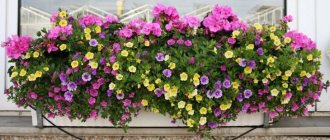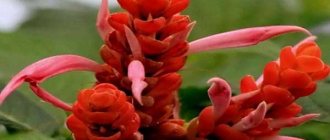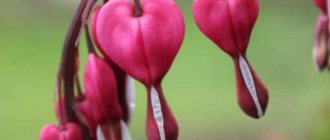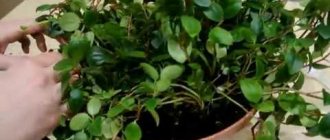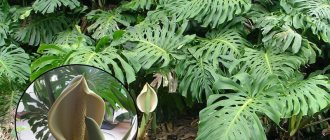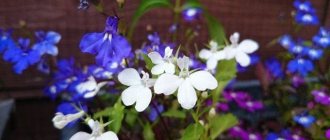Features of mimosa behavior
Mimosa does not tolerate touching; when shaken, it immediately rolls its leaves into a tube. This also happens when the temperature fluctuates, after sunset. After some time, the flower opens its plates again.
Botanical experts explain this by saying that the plant thus protects itself from tropical downpours in the wild. When it rains, it closes its leaves, and when the sun comes out, it opens.
The structure of mimosa
Mimosa - description
Mimosa (lat. Mimosa) belongs to the mimosa family and, depending on the source, has 300-450 plant species. Natural habitat - subtropical and tropical America, Africa, Asia.
Related article: Nertera flower: home care, photos and types, propagation and replanting
Representatives of the genus are herbaceous plants, trees and shrubs. Not all species are grown in culture; the most common is the bashful mimosa (Mimosa pudica). Mimosa flowers are small, collected in spikelets or heads. The leaves are bipinnate.
Mimosa is often used in the foreground of floral arrangements, which look more impressive due to the delicate inflorescences of this plant. Mimosa looks best against a light background.
Types of mimosa
The following types of mimosa are adapted for cultivation in indoor and garden conditions:
| Name | Description |
| Shy | Also called silver locust. The most popular variety. It grows wild in Brazil. In summer it blooms purple-pink buds. Cultivated as an annual plant. |
| Rough | Grows in the forests of South America. The buds are snow-white, collected in inflorescences. |
| Lazy | The flowers are white, small, and look very decorative. Reaches 50 cm. Stems are erect, branched. The leaves are fern-like. |

Origin and description of Mimosa pudica
Mimosa pudica (lat. Mimosa pudica) is a herbaceous (semi-shrub) plant from the genus Mimosa, which came to us from the tropical forests of South America and has become widespread throughout the world as an exotic flower.
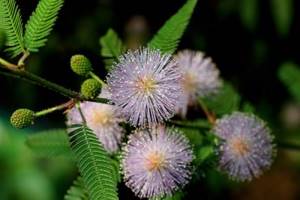
Mimosa pudica is a herbaceous (semi-shrub) plant from South America.
In nature, it reaches a height of up to one and a half meters; as an ornamental plant it can grow up to 30–60 cm. The stem is covered with spines, the seeds ripen in pods, like all representatives of the legume family, and the leaves react to touch and lack of light, folding towards the stem, which causes genuine delight among people observing this effect. In fact, this behavior of the flower is caused by saving moisture and sunlight in conditions of survival in the tropical forest.
This is what this plant looks like in nature
Since this mimosa came to us from countries with a tropical climate, it needs to create conditions similar to the South American tropical nature: sufficient light, high humidity and, of course, warmth. Therefore, it can only be bred in greenhouses or at home.
Photo gallery: shy mimosa grown in a pot
Important! Mimosa does not tolerate tobacco smoke, and if someone smokes in the house, it can die.
Growing and caring for mimosa at home
Mimosa is unpretentious in maintenance. However, caring for a bush at home requires following certain rules:
| Factor | Spring Summer | Autumn winter |
| Location/lighting | Near the western and eastern windows, where direct sunlight does not penetrate. Loves bright light, but needs to be accustomed to it gradually. | Dark, cool room. There is no need for additional lighting. |
| Temperature | +20…+24 °С. | +16…+18 °С. |
| Humidity | High, 80-85%. Next to the plant you can place a basin with wet moss or expanded clay. Daily spraying with settled water without bleach is necessary. It is also advisable to install a humidifier in the room with mimosa. | |
| Watering | Abundant, once every 2-3 days. | In autumn it is moderate, in winter only when necessary (when the bush dries out). |
| Top dressing | Every 2 weeks with mineral fertilizers with a high concentration of phosphorus and potassium. The dosage indicated on the package should be reduced by 2 times. | Not necessary. |
Diseases and pests
The main problems with mimosa are usually associated with improper care. Most often this is expressed by yellowing and falling leaves. If the room is cold and there is not enough light, then the plant may not bloom.

Whitefly
The most dangerous pests for mimosa are aphids, spider mites and whiteflies. An effective method of combating them is to treat the bush with insecticides.
Additional Information. If the insects have appeared recently, treating the leaves with a soapy solution may help.
Thus, with proper care, you can grow a bright plant at home, which with its flowers will symbolize the onset of spring.
Caring for mimosa outdoors
In its natural environment, mimosa lives in the tropics, so it is difficult to grow it in the climate of our country. Usually the plant is kept in greenhouses, houses, winter gardens, and greenhouses. In regions with warm winters, the bush can be planted in open ground, but it is necessary to provide proper care for it:
| Parameter | Conditions |
| Location/lighting | Southern, southeastern, southwestern, eastern, western parts of the site. The plant must be protected from drafts. Young specimens require shading. When the bush gets used to ultraviolet rays, it is transplanted to the south side. Bright sunlight, if in the shade, the mimosa will lose its decorative effect and stop blooming. |
| Temperature | Not lower than +10 °C. |
| Humidity/irrigation | The first time after planting, watering is carried out regularly for better rooting. After a few months they are stopped. Mimosa is drought tolerant, but in very hot weather it needs to be watered. The soil is moistened with rain or river water. If this is not possible, you can take tap water, filter it, boil it and let it sit for a couple of days. |
| The soil | Drainage is necessary to prevent moisture stagnation. It is laid out from expanded clay of the middle fraction. The substrate can be made from an equal amount of turf, peat, humus, and sand. After planting, the soil is regularly loosened and weeds are removed. |
| Feeding | Produced during the growing season (spring-summer). Twice a month you need to apply mineral fertilizers when buds appear - mixtures for beautifully flowering plants. |

Features of pruning and transplanting mimosa
Buds appear only on young shoots. In order to have more new branches, it is necessary to pinch. Thanks to this, the bush will bloom longer. Pruning is also necessary so that the stem does not stretch and the mimosa does not lose its decorative effect.
The first time it is done is in early April, next after the end of flowering. For it to be beneficial, the main thing is not to overdo it, cut only very elongated shoots, otherwise the bush will die.
When mimosa is grown as an annual, replanting is not necessary. If the bush is preserved after winter dormancy, it is already cramped in the old pot. The plant is moved to a new pot using the transshipment method, without destroying the earthen ball. The remaining voids are filled with fresh soil mixture. It is made from the same components as the substrate for initial planting (when purchasing a mimosa, you need to specify in what soil it is planted). After transplanting, the bush is watered.
Mimosa propagation
Mimosa is bred from seeds and cuttings. The first method is used in February:
- Distribute the seed evenly over the ground.
- Sprinkle a little sand.
- To stratify, place the container in the refrigerator for a month.
- At the beginning of spring, move it to a room with a temperature of +25 °C.
- After a few true leaves appear, transplant the sprouts into separate pots.

Step-by-step propagation by cuttings:
- Cut 10 cm cuttings from the tops of the branches.
- Cut off the lateral shoots and place in Kornevin for 8 hours.
- Plant into the soil to a depth of 2 internodes.
- Cover with glass and place in a warm, well-lit place.
- Remove the cover daily for ventilation and watering.
- Rooting will occur in 2-3 months.
Growing and care
Despite its external fragility and tenderness, the culture is considered unpretentious in care . It is a heat-loving plant, so it develops well at a temperature of 20-24 degrees Celsius. In winter, mimosa can grow at 16-18 degrees. For normal development, the plant needs a lot of light, and it tolerates even direct rays of the sun well. If the flower is placed on the sunny side, it still needs to be placed in partial shade for several hours a day.
The plant needs clean air, but it does not tolerate drafts. It cannot be placed in the kitchen or in a room where someone smokes, because upon contact with tobacco smoke, the mimosa immediately sheds its leaves.
Flower propagation
It is better to grow this crop from seeds that are planted in late winter - early spring. They need to be sown according to the following scheme:

Place a layer of drainage (pebbles, expanded clay or crushed stone) in a small container.- Pour soil into the pot. You can take a purchased substrate for flowering plants or prepare a nutrient mixture yourself by mixing equal parts of deciduous soil, peat, sand and turf.
- Water the soil and sow the seeds, sprinkling them with no more than 1 cm of soil.
- Place the container in a well-lit place with a temperature of at least 25 degrees. For additional insulation, the container can be covered with film.
The pot with seeds should be watered regularly, preventing the soil from drying out . For this it is better to use a spray bottle. When the first shoots appear, the plants need to be planted in different containers, placing them in a place with good lighting, but not in direct sunlight. After the third leaf appears on young mimosas, they should be transplanted into soil for adult flowers. When diving, be careful not to damage the delicate roots of the plant.
You can also get a flower from a cutting, but this method is considered less effective, since the shoots are quite difficult to root. In order for them to start sprouting roots, they should be placed in warm water or soil made of sand and peat, watering the shoots daily. Rooting should occur in 1.5-2 months.
Watering and fertilizing
Mimosa flowers need abundant and regular watering , especially in summer. They should be moistened with distilled or at least settled water at room temperature. Watering is carried out in the morning or evening if the top layer of soil is slightly dry. It is worth making sure that there is always water in the tray of the pot.
In spring and summer, the air around the plant also needs to be sprayed daily with a spray bottle, being careful not to get it on the flower itself. To combat dry air, you can also place a container with wet stones or water next to the mimosa.
During the period of active growth, it is advisable to fertilize mimosa. To do this, you should use mineral complexes for flowering plants. Fertilizers should be applied 2-3 times a month to the soil of the pot, diluting them twice with water.
Breeding problems
Mimosa is rarely affected by disease, but it can sometimes suffer from pest infestations and other problems. When growing this crop you may encounter the following difficulties:
- Apple aphid - this parasite causes the growth of the flower to slow down and its leaves begin to change shape. To combat it, you should purchase a special insecticide.
- Mealybug - to eliminate it, you need to treat the plant with a cotton pad soaked in alcohol. In addition, you will need an anticoccidal complex.
- Spider mites - treatment with acaricides helps.
- Curled leaves - this symptom indicates constant smoke in the room or dirty air. You need to either move the flower to another room, or start regularly ventilating the room, having first protected the flower from drafts.
- Wilting, yellowing or falling leaves - such a problem indicates low humidity or insufficient watering.
- Constantly closed foliage during the daytime - this disadvantage is associated with excessive watering or violation of the temperature regime.
- Elongated shoots of the plant - this is due to poor lighting. You need to move the pot to a sunnier place or extend daylight hours with the help of lamps.
- The bush does not want to bloom - this means that the plant is too cold.
The plant may not develop well in a house where there are small children. Kids may be interested in it because of its ability to curl leaves when touched. For a flower, frequent folding of leaves is considered stress, because it spends its vital energy on this, so it does not have enough strength to develop. In this case, it is worth moving the culture to a place inaccessible to the child.
Possible troubles, pests and diseases of mimosa
If there are deficiencies in care, the following problems may arise:
| Manifestations | Causes | Corrective measures |
| Sugary sticky coating, the presence of small, green or black insects. | Aphids, due to high humidity. |
|
| Deformation and fall of greenery. Thin web on the inside of the leaves and in the internodes. | Spider mites, due to the large amount of moisture in the air. |
|
| Yellowing and falling leaves. Do not open them during the day. | Excess moisture. | Follow the watering schedule. |
| Strong stretching of stems. | Lack of light. | Move to a well-lit place. |
| Lack of flowering. |
| Normalize conditions of detention. |
| The appearance of dry light brown spots. Grayish fluff on the stem. | Gray rot, due to excessive soil moisture, hypothermia. |
|
Watering and air humidity for mimosa pudica
The watering schedule for mimosa is standard. During the period of active growth and flowering, the plant is watered frequently and abundantly, allowing the upper layer of the substrate in the containers to dry out. As soon as the mimosa goes into a dormant period and stops growing, watering is reduced and made more rare, but still maintains stable light humidity, preventing the substrate from drying out even in the middle layer. Both in winter and summer, this plant will not forgive either complete drought or overwatering.
For mimosa pudica, use standard settled water. Watering must be supplemented by periodic loosening of the top layer of soil, preventing it from compacting and forming a crust.
One of the difficult aspects in growing mimosa pudica is its love for high air humidity. In this regard, mimosa is a typical South American exotic. You can satisfy the needs of the plant by simple frequent spraying, but it is better to combine spraying with the installation of home humidifiers - trays with wet moss or decorative stones under the plant (but without contact of the bottom with water).
